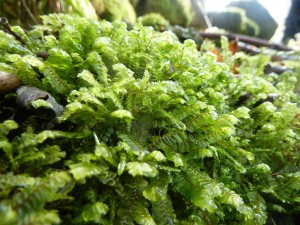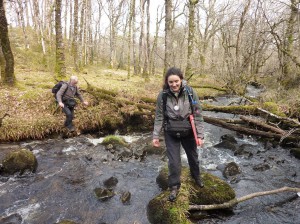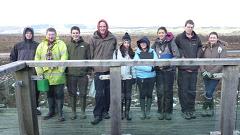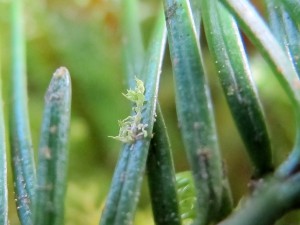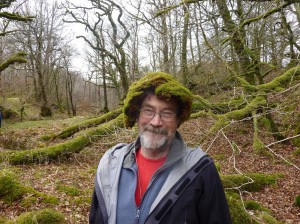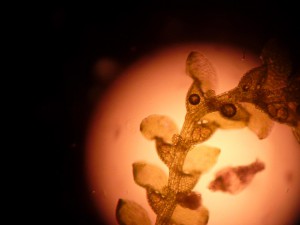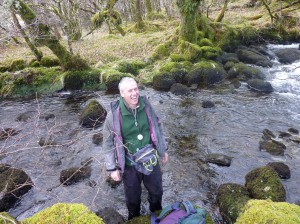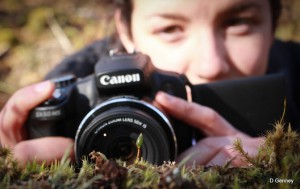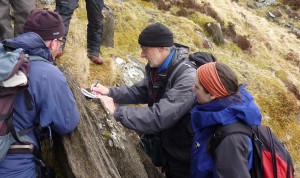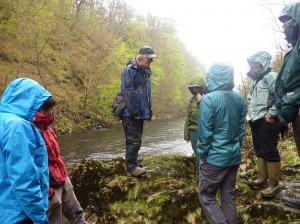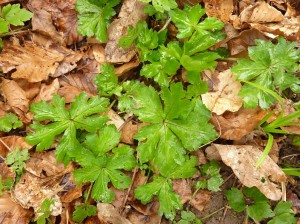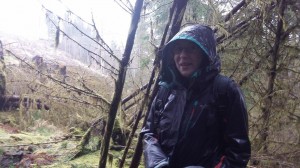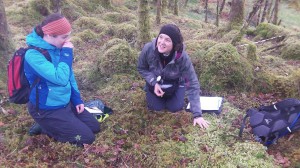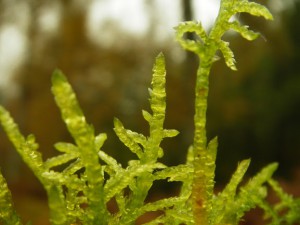
Time has flown since I started my apprenticeship in November last year and I can’t believe I am now half way through the apprenticeship! So, with my tail between my legs for not blogging sooner, here is an update on the many experiences I’ve had since it all began and a mention for the people who have helped me throughout. This is, therefore, a pretty mahoosive blog, so feel free to simply enjoy the photos!
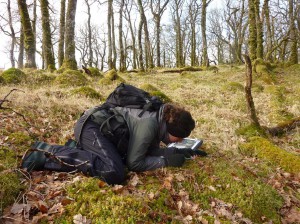
I have been initiated into the world of bryologising! Getting up close and personal with the woodland floor!
In the Begining……..
The first few months of the apprenticeship aimed to get me up to speed with many of the common woodland bryophytes. With 977 mosses and liverworts in Scotland I had plenty to be getting on with! With huge support from my mentors Liz Kungu, David Long and David Chamberlain, from the Royal Botanic Garden Edinburgh, we surveyed six woodland sites identified by The Wildlife Information Centre for the Lothians and Borders. We recorded seven new vice county records during these surveys, which in other words are records of species which have now been recorded for the first time ever in these vice counties! All our records have been submitted to the British Bryological Society and these will be added to the revised addition of the Atlas of the Bryophytes of Britain and Ireland. Regular recording is important to contribute to knowledge of the distribution of species, understanding of any change over time and to underpin decisions regarding conservation value and management. Here are pictures of some of the magnificently beautiful mosses and liverworts that we recorded!
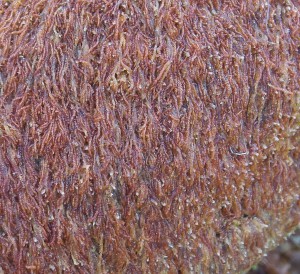
Nowellia curvifolia is one of the most common liverworts found on deadwood. It can cover whole logs and can be seen from a distance as the whole log will appear crimson red. Looking at an individual shoot under a hand lens will reveal leaf lobes which ‘hug’ the stem with long curving lobes. A very distinctive liverwort!
Some other favourites are Metzgeria furcata and Scapania nemorea, especially when they have been expertly photographed by David Genney (Lower Plants Officer for SNH).
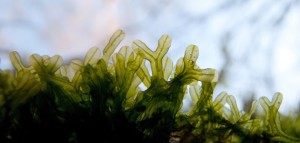
Metzgeria furcata (photograph here by David Genney) is a very common liverwort on trees and is easily identified by it’s flat shoots that are forked at the tip.
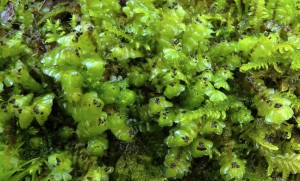
Scapania nemorea (D.Genney) is readily identified when the dark brown gemmae are present on the tips of the shoots.
It is always nice to be confident about identifications in the field, but checking identifications with the microscope when necessary is just extra fun.
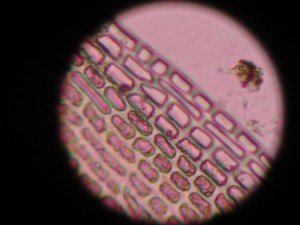
- Cells on the leaf margins, towards the base of the leaves, are distinguishing characters for confirming identification of Grimmia lisae, which we recorded as a new vice county record for Peebleshire.
Flanders Moss!
I have also enjoyed assisting in the delivery of a bio-recording workshop at Flanders Moss training day with Niall Currie (Urban Biodiversity Apprentice – Buglife) and assisting my mentor Liz Kungu with a bryophyte workshop at Vogrie country park.
The West Coast Beckons!
The ‘big project’ and main aim of my apprenticeship is to survey oceanic ravines on the west coast of Scotland. Therefore, my bryophyte training has taken me further west and north to wetter but often warmer locations to some of Scotland’s best semi-natural habitats.
Early in the year I visited Benmore Botanic Garden and despite the snow Gordon Rothero and Liz Kungu embarked upon some survey work with me in the gardens and surrounding countryside. Liz and I refound an unusual non-native liverwort called Telaranea tetradactyla and I studied the occurrence of a tiny liverwort Colura calyptrifolia. I recorded Colura calyptrifolia growing as an epiphyll (on the surface of the leaves) on conifers. The occurrence of this oceanic liverwort is now not an unusual observation, as it is a relatively recent coloniser of conifers on the oceanic west coast of Britain, however, the intrigue of discovering its presence is insatiable (see photo!) and it is important to record its spread, notably the fact that it is growing as an epiphyll.
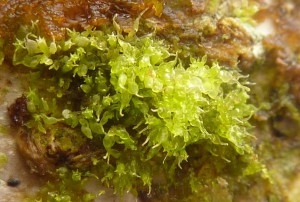
- Colura calyptrifolia is a lovely enchanting little liverwort! There is nothing else like it in Britain and it is very distinctive with long drawn out beaks on the leaves.
Gordon, being a tutoring genius, took me to see the nationally rare Daltonia splachnoides and then showed me the wonders of my first oceanic ravine where I saw copious amounts of oceanic species including Radula voluta, Harpalejeunea molleri and Plagiochila bifaria to name a few.
A perfect way to follow this up was the offer of accompanying Stan Phillips (SNH Area Manager West Argyll) to revisit some well known oceanic ravines and Atlantic oak wood. Stan introduced me to a number of new species, notable species nonetheless (!) including Cololejeunea calcarea, Lophocolea fragrans and the nationally rare Acrobolbus wilsonii and Radula carringtonii. Getting familiar with oceanic species and assisting in monitoring these rarer species was one of the many highlights of the apprenticeship thus far.
Following this I accompanied Gordon to survey more ravines, allowing me to get more familiar with oceanic liverworts and mosses, and learn plenty more too. Gordon was happy for me to ‘pickle’ his brain for information on identifying bryophytes from dusk till dawn in the field and at the microscopes! Towards the end of this trip I had the opportunity to see one of Britain’s only moss species with European protected species status, Buxbaumia viridis (Annex II Habitats Directive) and on the same trip Dave Genney and I recorded the non-native liverwort Lophocolea semiteres near Beauly. This was a new vice county record for Inverness-shire and the most northerly record in Britain to date.
In April I attended Nick Hodgetts Mosses and Liverworts course at Kindrogan Field Studies Council Centre. During the course of the week Nick took the group to a variety of habitats, which was a perfect opportunity to put my growing bryophyte knowledge into practice as we recorded a total of 279 species and I gained exposure to 50 new species! To my delight we recorded 20 Sphagnum species in one day, including all of the ‘chunky’ peat building bog mosses, indicative of an active peat forming bog. In addition, a first for me was being introduced to Sphagnum affine, which within Britain is highly localised with a western distribution. Now I have my ‘eye in’ for recording more records of this moss in future.
I also attended an NVC Woodlands course at Kindrogan, lead by Ben Averis. It was an absolute delight learning from Ben how to identify woodland habitats using the NVC categories and descriptions and it allowed me to focus for a while on some of those vascular plants that I have ignored for a while due to bryophytes stealing all my attention!
The penultimate survey I undertook was an incredible opportunity to survey plantation ancient woodland sites in west Argyll, a project made possible by Richard Thompson and Philippa Revill from Forestry Commission. With the support of David Long, Liz Kungu and Gordon Rothero this project allowed me to survey a total of 182 bryophytes across six different sites, including the nationally scarce Leptoscyphus cuneifolius and Anastrophyllum hellerianum. The former species (with dainty little wedge shaped leaves that can be readily identified in the field under a hand lens) was present in an abundance not seen elsewhere by my mentors and finding new locations of the Anastrophyllum hellerianum for myself was a real thrill. I produced a report and presented feedback to the Forestry Commission.
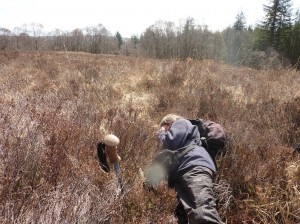
- Liz Kungu surveying the bog and finding more Colura calyptrifolia on the heather!
-
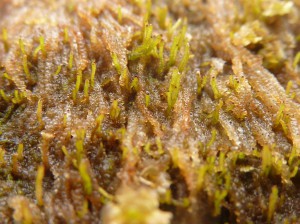
Look what Liz, Stan and I found! The nationally scarce Anastrophyllum hellerianum creeping through Nowellia curvifolia on deadwood.
Huge thanks are due to Janet MacLean (Aberdeen University and the James Hutton Institute), Heather Campbell (TCV) and Noelia Colado Salas (TCV) for all their help and companionship during these surveys, even in the rain 🙂
Whats Next?
The immediate future sees me heading over to start surveying new territory in west coast ravines in the Highlands and I will also be attending British Bryological Society field meetings in Kinlochewe and on Rasaay. I also look forward to the upcoming RBGE Bioblitz on June 22nd; delivery of a workshop for Central Scotland Forest Trust in Drumpellier on Saturday 31st August and assisting with TCV events at a Pollock family day on 3rd August and in Edinburgh on 1st September.
I’ll leave you with this lovely robust moss, Pseudoscleropodium purum….the latin name rolls of the tongue..just try and see!

